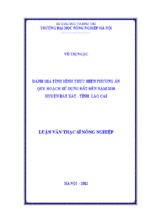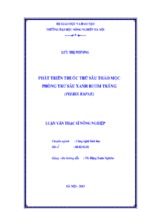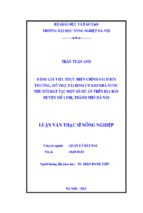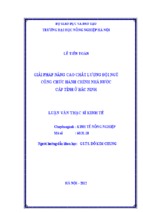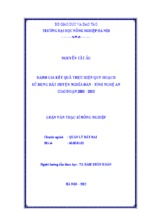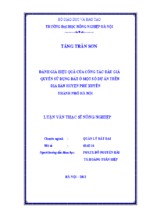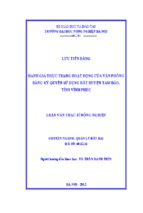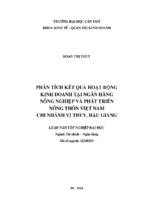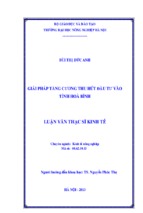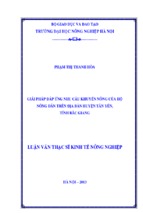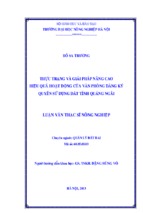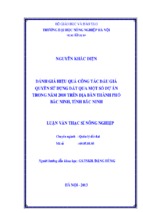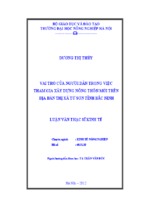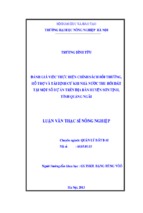THAI NGUYEN UNIVERSITY
SCHOOL OF FOREIGN LANGUAGES
LE THI BAY
THE EFFECT OF GAMES ON GRADE 10TH STUDENTS’ MOTIVATION
IN ENGLISH CLASS AT TRAN HUNG DAO HIGH SCHOOL
(Ảnh hưởng của trò chơi đối với động lực học của học sinh khối 10
trong lớp học tiếng Anh tại trường trung học Trần Hưng Đạo)
M.A. THESIS
Field: English Language
Code: 8220201
Thai Nguyen, 2019
THAI NGUYEN UNIVERSITY
SCHOOL OF FOREIGN LANGUAGES
LE THI BAY
THE EFFECT OF GAMES ON GRADE 10TH STUDENTS’ MOTIVATION
IN ENGLISH CLASS AT TRAN HUNG DAO HIGH SCHOOL.
(Ảnh hưởng của trò chơi đối với động lực học của học sinh khối 10
trong lớp học tiếng Anh tại trường trung học Trần Hưng Đạo)
M.A. THESIS
APPLICATION ORIENTED
Field: English Language
Code: 8220201
Supervisor: Dr. Duong Duc Minh
Thai Nguyen, 2019
DECLARATION
I hereby declare that the minor thesis entitled “The effect of games on grade 10th
students’ motivation in English class at Tran Hung Dao high school” is my own
work. To the best of my knowledge, it contains no materials previously published or
written by another person, or substantial proportion of material which have been
accepted for the award of any other degree or diploma at the School of Foreign
Languages – Thai Nguyen University or any other education institutions. The thesis
has not been submitted to any other examining body and has not been published.
Any contribution made to the research by others is explicitly acknowledged in the
thesis.
The candidate.
Le Thi Bay
Supervisor
Dr. Duong Duc Minh
i
ACKNOWLEGEMENTS
This research paper would not have been completed without the help of
many people to whom I would like to express my deep gratitude.
First and foremost, I would like to express my deepest gratitude to my
supervisor, Mr. Duong Duc Minh, Ph.D. for his wholehearted support, continuous
motivation and precious guidance which was decisive factors to the completion of
the thesis.
I thank all my family and dear friends for their lifting my spirits at each
turning point of this journey as well as for their great encouragement and valuable
help during the data collection process.
Last but not least, I extend my special thanks to all the research participants.
Without their valuable opinions and ideas in the questionnaires, the study would
not have been accomplished.
ii
ABSTRACT
This paper aims at investigating the effect of games on grade 10th students’
motivation in English class at Tran Hung Dao high school, Quang Ninh province
and seeks to determine the extent to which using games in learning process affects
the improvement in students’ motivation in learning process, how students
experience the teacher’s practice and behavior and measure the students’
perceptions of the using games in learning environment with respect to its
effectiveness. Questionnaire, observation and structured interview were used as the
main tools to collect data. Both quantitative and qualitative data analysis methods
were used to provide enough data for the present study. The results from the data
revealed that the using games in learning process significantly affected students’
motivation in language classes. In addition, most of the students involved in the
study are generally happy about using language games in their study and they
recognize the benefits of the language games in enhancing interaction between them
and their classmates as well as their teacher.
Key words: language games, high school students, motivation, attitudes,
performance
iii
TABLE OF CONTENTS
DECLARATION ............................................................................................... i.
ACKNOWLEGEMENTS ................................................................................. ii.
ABSTRACT ...................................................................................................... iii
LIST OF ABBREVIATIONS ........................................................................... vi
LISTS OF TABLES AND FIGURES ............................................................. vii
PART 1: INTRODUCTION .............................................................................. 1
1. Rationale ................................................................................................. 1.
2. Aims of the thesis .................................................................................... 3
3. Scope of the thesis ................................................................................... 3
4. Significance of the thesis ......................................................................... 3
5. Structure of the thesis .............................................................................. 4
PART 2: DEVELOPMENT ............................................................................... 6
CHAPTER 1: LITERATURE REVIEW ........................................................... 6
1. Definition of motivation ......................................................................... 6.
2. Definition of games ................................................................................. 8
3. Educational games ................................................................................... 9
4. Games in English language teaching ....................................................... 9
5. Previous studies ..................................................................................... 12
CHAPTER 2: RESEARCH METHODOLOGY ............................................. 15
1. Research design .................................................................................... 15.
2. Research procedure.............................................................................. .15.
3. Participants ............................................................................................ 17
4. Instruments ............................................................................................ 18
5. Data collection procedures .................................................................... 19
6. Data analysis ......................................................................................... 20
7. Summary ............................................................................................... 20
CHAPTER 3: RESULTS AND DISCUSSIONS............................................. 21
I. Results .................................................................................................... 21
1.1. Results of questionnaire
.............................................................. 21
iv
1.2. Results of observation
................................................................. 25
1.3. Results of Semi-structures interview
............................................. 26
II. Discussions ........................................................................................... 28
PART 3: CONCLUSION AND RECOMENDATIONS ................................. 32
1. Recapitulation ........................................................................................ 32
2. Implication ............................................................................................. 33
3. Limitations ........................................................................................... .34.
4. Recommendations and suggestions for further study .......................... .34.
REFERENCES ................................................................................................. 37
APPENDICES ..................................................................................................... I
APPENDIX 1: .................................................................................................... I
APPENDIX 2: .................................................................................................. III
APPENDIX 3: ................................................................................................. IV
APPENDIX 4: .................................................................................................. V
APPENDIX 5: .................................................................................................. VI
v
LIST OF ABBREVIATIONS
MMOs:
Massively multiplayer online games
NFL:
National foreign language
PPP:
Present- practice- produce technique
vi
LISTS OF TABLES AND FIGURES
page
Chart 1: Students’ ideas of the importance of using games in English
learning process
21
Chart 2: Students’ opinion of using games in real contexts
22
Chart 3: Students’ understanding of the lesson
22
Chart 4: Students’ attitude to teaching method
23
Chart 5: Students’ interaction in English lessons
24
Chart 6: Students’ difficulties in playing games
24
Chart 7: Comparison of students’ motivation through lessons.
25
vii
PART 1: INTRODUCTION
1. Rationale.
In the current globalization and integration trend, English is considered to be
the most widely used language in the world, as nearly 60 countries use English as
their primary language, their mother tongue, and nearly 100 countries use English
as second-language English. Therefore, this foreign language plays a very
important role in the current integration of globalization.
Human relations as well as cooperation, investment in any fields from
science, business, commerce, transportation, technology, communication, tourism
to the opportunities in learning, expanding ties to co-operate not only in Vietnam
but also in other regions of the world. Especially since Vietnam became the 150th
member of the World Trade Organization and the transformation of Vietnam, the
world during the Industrial Revolution 4.0. We are entering a new economic phase
with many opportunities and challenges. With the opening of the market we have a
very strong economic development opportunity, along with the demand for high
quality human resources meeting labor requirements in the age of integration,
English is one of the tools that help us to reach and grasp those opportunities.
Therefore, the demand for training and development of foreign languages,
especially English in Vietnam is increasingly focused and enhanced. However, at
present, although the focus on foreign language training at the school level, the
results have not yet reached the required standards. The objectives set out in the
project "Teaching and learning foreign languages in the national education system
for the period of 2008 - 2020" have created a strong impetus in teaching and
learning foreign languages; However, from the objective to the actual results of the
project, the distance is very far. On November 16, 2016, Mr. Phung Xuan Nha Minister of Education and Training announced that “the government had failed to
meet the goals of the NFL scheme for the 2008-2020 periods” (VN, 2016). Limited
English proficiency results in loss of the opportunity to study and work for many
students.
1
So as to learn a language well, students demand a relaxed atmosphere that
increases motivating and this can be gained through games. Using games in
teaching not only helps students to learn better but also increase students'
motivation, rapport, cooperation and social interaction. On the one hand, playing
games helped the students get ability for language, this good language ability helps
students be self-confident and express themselves in their future life.
The game is very useful to improve motivation among shy students who
cannot express their feelings or thoughts in front of others. By using the game,
students can be more active, self-reliant and energetic to study about the
environment, the world they live in, and take part in the teaching and learning
process. We can teach all skills and components through game play, based on a
learner-centered approach, while we are teaching; we must pay attention to the
meaning, relevance and level of learners (Widodo, 2006)
At Tran Hung Dao High School, students live mainly in mountainous areas,
with difficult conditions, their English communication environment is not
available, and having a few chances to access learning languages resources as well
as opportunities to communicate in foreign languages. Most students who have
moderate level of learning, limited access to learning and access to outside
knowledge, lack of opportunity to practice communication, Besides, being a
foreign language teacher, the researcher have been step by step innovating,
integrating and diversifying teaching methods into teaching periods in my classes
to create the most comfortable atmosphere as possible for students to access the
foreign language what they are learning best
Adding that, teaching English in most of Vietnam public schools often only
focuses on tasks and exercises in the textbook, lack of many important activities,
such as: active discovery, analysis, interpretation, problem-solving, memory, and
physical activities, which leads to the boredom and be difficult for motivating
students in learning foreign language. Hence in order to improve the teaching
English in the classes more and more efficiently, as well as overcome these
2
weaknesses, that is reason the researcher conduct the research “The effect of games
on grade 10th students' motivation in English language class at Tran Hung Dao
high school”. And this research was implemented at Tran Hung Dao High School,
Quang Ninh Province.
2. Aims of the thesis.
This study aims to find out the using of language games in teaching and
learning foreign language and its role in promoting students’ motivation in learning
English.
Especially, the research attempts to discover whether using games in the
classroom makes the Tran Hung Dao high school students motivated to learn
English. Based on this information, the study tries to give satisfactory answers to
the following research questions:
1. What is the impact of using games on grade 10th students’ motivation in
Tran Hung Dao high school?
2. What are the students’ attitudes towards using games in the English
foreign language classroom?
3. Scope of the thesis
This study only focused on using language games in teaching to stimulate
student’s motivation in learning English for 10th students at Tran Hung Dao high
school, Dong Trieu district, Quang Ninh Province. The scope of this research
included the students in classes 10A1 with the total of 38 students include 20
females and 18 males at Tran Hung Dao high school. Most of them come from
mountainous areas not have many opportunities to learn English.
4. Significance of the thesis
Findings from this thesis contributed to the field of promoting student
motivation in learning English process. First, this study provides a suitable
3
approach for teachers to enhance the quality of teaching and learning process in
Vietnam.
Another possible contribution of this study focuses on evaluating the
productiveness and learner attitudes and motivation of using games in learning
process in order to determine the changes for improvements in terms of teaching
and learning methods.
Last but not least, the study contributed to dealing with the investigation of
how teacher practice and behavior may influence student’s satisfaction of using
games in learning environment.
5. Structure of the thesis
Part 1: Introduction
This part is the introduction which contains the rationale, aims and
objectives, the research questions, the scope, the methods, the significance of the
thesis.
Part 2: Development.
Chapter 1: Literature review.
This chapter is the literature review which includes an overview of the
theoretical background and the previous researches related to the study.
Chapter 2: Research methodology.
This chapter presents in details about the method of the study restating the
research questions and describes the setting where the study is conducted, the
participants, and the instruments used to collect data, and the procedures of data
collection.
Chapter 3: Findings and Discussion.
This chapter focuses on the results of data analysis and the findings are
shown which aims at describing the analysis of data in detail and giving the
summary of the findings as well as a thorough discussion of the findings of the
4
study. Some explanations and interpretations of the findings are also presented in
this chapter.
Part 3: Conclusions and Recommendations.
This part includes the conclusion, recommendation, limitations of the study
and some suggestions for further research.
5
PART 2: DEVELOPMENT
CHAPTER 1: LITERATURE REVIEW
1. Definition of motivation.
Gardner (1985) said that motivation is perceived as a goal-directed factor
since it involves four aspects: a goal, effortful behavior, a desire to reach the goal,
and favorable attitudes toward an activity. Motivation works as the starting point
for learning and supporting the process of foreign language learning. In fact, if
there is lack of motivation, no student will be able to continue with the process of
achieving language proficiency; in the other word, high motivation will be useful
for learners to attain proper proficiency in the second language, even if their ability
or learning conditions are not appropriate (Cheng & Dörnyei, 2007). Motivation
has been admitted as a remarkable factor in language learning success. Motivation
research has evolved over the years through several stages demonstrating gradual
integration with developments in motivational psychology, while having a clear
focus on aspects of motivation related to language learning (Ushioda & Dörnyei,
2012).
Harmer (2002) said that motivation is a type of initiative that encourages
someone to do things to reach a goal. Moreover, this is fundamental to succeed in
most fields of learning; without such motivation, we will not be able to make the
effort to learn. So, it is necessary to understand the its role when learning a
language. The author distinguishes between extrinsic and intrinsic motivation
coming from outside and inside the individual respectively.
Brown (2001) states intrinsic motivation is one of the aspects that helps
students succeed in language learning. Of course, there are other factors involved
in language learning success, but if learners are provided with opportunities in the
classroom to practise the language without depending so much on outdoor rewards
for their motivation, they will have a better chance to succeed. When students
6
practise the language for their own personal reasons to become proficient, they will
be able to develop their own competence and autonomy to learn the language.
Research has admitted intrinsic motivation as a decisive factor to stimulate
success. Furthermore, in a model of intrinsic motivation proposed by Vallerand
(1997), he found that intrinsic motivation is related to knowledge, accomplishment,
and stimulation. These three aspects are respectively associated with exploring new
ideas and developing knowledge, sensations embraced in attempting to master a
task or achieve a goal, and sensations stimulated by performing the task. This kind
of motivation is referred to as extrinsic motivation, the motivation that students
bring into the classroom from outside (Harmer, 2007).
According to Thomas (2004), Robbins and Timothy (2007). “Motivation is
the driving force by which humans achieve their goals. Motivation is said to be
intrinsic or extrinsic. The term is generally used for humans but it can also be used
to describe the causes for animal behavior as well”. This study refers to human
motivation. According to various theories, motivation may be rooted in a basic
need to minimize physical pain and maximize pleasure, or it may include specific
needs such as eating and resting, or a desired object, goal, state of being, ideal, or it
may be attributed to less-apparent reasons such as altruism, selfishness, morality,
or avoiding mortality. Conceptually, motivation should not be confused with either
volition or optimism. Motivation is related to, but distinct from emotion.
However, in order to understand of terms used in this study, the following
definitions are given to research.
The students’ motivation is the desire to attend and learn the contents of the
subject or the study program, which is the decision-making process of students on
the orientation, concentration and efforts of students in the study process. Learning
motivation increases the knowledge and skills acquired by students in the learning
process. This is reflected in their academic results. Students will not be able to get
the best learning results if they do not have the right learning attitude. Learning
attitude, in which motivation is the deciding factor.
7
2. Definition of games.
The Longman Dictionary of Language Teaching and Applied Linguistics
(Richards, Platt, & Platt, 1995, p. 89), game is defined as “an organized activity
that usually has the following properties, a particular task or objective, a set of
rules, competition between players, and communication between players by spoken
or written language” In addition, Flexner & Hauck (as cited from Deng, 2006, p. 3)
states that “game is a competitive activity involving skills, chance, or endurance on
the part of two or more persons who play according to a set of rules, usually for
their own amusement or for spectators”
According to Martinson and Sauman (2008, p. 478), “Games are effective
tools for learning because they offer students a hypothetical environment in which
they can explore alternative decisions without the risk of failure. Thought and
action are combined into purposeful behavior to gain a goal. Playing games teaches
students how to strategize, to consider alternatives, and to think flexibly”. In other
words, games are fun activities that help promote thinking, learning, interacting
and solving problem. Normally, games have an aspect that permits the players to
produce information in a short time period. Some games require the players to
participate in a physical activity or complete a mental challenge.
However, Lengelling and Malarcher (1997) say that choosing a game is not
easy task, it should be governed by some rules to guarantee the success of them.
So, while planning games, teachers should take into consideration the following
features: Classroom space, noise, materials necessary for the game, the amount of
time needed for each game, and the level, culture, interest and age of students.
In fact, games are also classified by many ways in language English
teaching. According to Hadfield (1999), she explains two ways of classifying
language games. The first, she divides language games into two categories:
language games and communication games. Language games focus on accuracy,
on the other hand, the game of communication focuse on the exchange of
information and ideas of success. The use of correct language, though still
8
important, is secondary to achieving communication goals. The second that
Hadfield used to classify language games has more categories. Just like classifying
games as language games or communication games, some games contain elements
of both types.
3. Educational games.
Like computer games or online games but these educational games focus on
playing in the classrooms, and the definition maintains that such games require the
involvement of rules, competition, relaxation and learning. A major purpose for
using games in class is to promote students' motivation in learning English.
Prensky (2006 and 2011) defined educational games as interactive plays that
teach us goals, rules, adaptation, problem solving, interaction, all represented as a
story. They give us the fundamental needs of learning by providing - enjoyment,
passionate involvement, structure, motivation, ego gratification, adrenaline,
creativity, social interaction and emotion.
4. Games in English language teaching.
Games are useful for students involved in the learning of English since
games can strengthen students’ motivation and self-confidence. Using games in
English teaching process to raise students' motivation and confidence which can
then promote higher levels of English learning process. By using a game which
helps students lots of opportunities to do, to act, and to move, they can acquire a
greater quantity of meaningful lesson.
Foreman (2003, p.16) states that “Learning through performance requires
active discovery, analysis, interpretation, problem-solving, memory, and physical
activity and extensive cognitive processing”. In other words, games provide a
constructivist classroom environment where students and their learning are central,
from there, students draw their own meaning from these experiences while learning
from their mistakes and also from each other.
9
In other words, games stimulate students’ activities in classroom and as a
result, students become motivated and willing to learn. Philips (1993) supports this
opinion by her statement that enjoyable activity is memorable then and the possible
success that the children could reach in language learning will develop motivation
for their further learning.
Games allow for creativity, independence and higher thinking. Usually,
questions made by the classroom teacher are fact based and have only one answer,
not allowing for creativity, personal expression. The answer is either right or
wrong, but games can allow for multiple answers. They improve participation, selfconfident, and vocabulary usage and moreover, games allow the students to see
that there are many ways to solve the same problem. It is more like real life.
Games also reinforce learning through many multiple intelligences. Since
individuals receive and process information in very different ways, it is important
that teachers use different styles and strategies. Games often combine logical
reasoning, communication, visual stimulation and spatial relations. Games include
analysis and explanation of new and old material which makes learning concrete.
Moreover, the hands-on experiences are integral to critical learning, retention and
recall.
Games stimulate interactivity. The students are actively processing and
working with the material and classmates. Specially, in a foreign language
classroom, it is imperative that the students practice speaking with each other. The
foreign language students' aim is to speak proficiently and independently in various
situations. He or she never may do so unless there are ample opportunities for
guided and independent practice. The interactivity among the students also
promotes a community of learners. The students will begin to meet each other as
individuals and will interact more about each other instead of seeing what they are
on the surface. Interactivity will remove stereotypes and barriers in a foreign
language classroom.
10
Games allow the students to work in group and to work collaboratively
towards a common goal. This cooperative effort is not only learning to work with
others but also promoting a symbiotic relationship where they can learn from each
other. Students must supply reasons for why their answer is the best, listen to their
teammates’ rationale and then determine which answer is the best and why. So, the
cooperative effort is promoting a spontaneous discussion about the material,
improving pronunciation, increasing participation, aiding in comprehension, all
while the students are thinking quickly on their feet. The students are also
developing trust and self-confident in this process. Trust develops within and
among the players. The students must trust their own instincts and others’ rationale
about the answer as well as the ability to produce it. Self- esteem grows as their
answers are validated and teammates rely on them to be pivotal players in the
game.
Using games in the language classroom enhances students’ motivation and
confidence in the process of learning when they achieve learning goals in a
relaxing environment.
Using game is a useful tool in improving children’s vocabulary acquisition in
as natural a way as would be normally achieved through play (Angelova &
Lekova, 1995; Atake, 2003; Deng, 2006).
In short, the use of games has great pedagogical value in enhancing students'
motivation and can be a springboard for teamwork. In a classroom based on
teaching through games, there are different types of motivated interactions that
make teaching-learning process enjoyable in learners-learners, learners and
teachers’ interactions.
In fact, games are closely connected with motivation. For instance, Khan
(1991, p. 143) points out usefulness of the game because of its motivating
importance. “It is clear then that games-since children naturally want to play them can be motivating.” McCallum (1980, p. 9) highlights this point by suggesting that
“games automatically stimulate student’s interest, a properly introduced game can
11
- Xem thêm -

